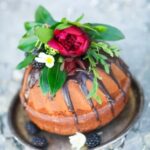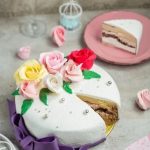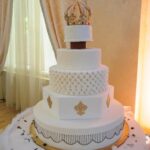The wedding cake holds a special place in Nigerian weddings, symbolizing love, unity, and celebration. In this article, we will explore the art of decorating Nigerian wedding cakes, focusing on the traditional designs and cultural elements that make them unique. From intricate patterns to vibrant colors, the decoration of a Nigerian wedding cake is a reflection of the rich heritage and customs of the diverse Nigerian culture.
When it comes to decorating a Nigerian wedding cake, attention to detail and symbolism are key. The design chosen for the cake often incorporates traditional motifs like geometric patterns, tribal symbols, or even personalized elements that hold significant meaning to the couple. Each decoration adds layers of meaning and beauty to the cake, making it a centerpiece of the celebration.
While taste is important when selecting flavors for the wedding cake, the visual appeal plays an equally crucial role. From choosing decadent flavors like red velvet or fruitcake to incorporating local favorites like coconut or plantain, selecting flavors that resonate with Nigerian culture can elevate the overall experience of enjoying a slice of wedding cake.
In the following sections, we will delve into traditional designs, step-by-step decorating techniques, and tips on achieving a flawless finish for a stunning Nigerian wedding cake that captures the essence of this joyous occasion.
Traditional Nigerian Wedding Cake Designs
Traditional Nigerian wedding cakes are known for their intricate designs and rich symbolism, reflecting the cultural heritage of the couple tying the knot. One of the most popular traditional designs seen on Nigerian wedding cakes is the use of Gele fabric patterns.
Gele is a type of head wrap worn by Nigerian women during special occasions, and incorporating these vibrant and colorful patterns onto the cake can add a traditional touch to the dessert. Another common design element is the Adire pattern, which features indigo-dyed textiles with unique motifs like flowers, leaves, or geometric shapes.
In addition to fabric patterns, Nigerian wedding cakes often feature symbolic elements that represent love, unity, and prosperity. The love knot design symbolizes the eternal bond between the couple, while the double rings motif signifies everlasting commitment.
Other popular symbols seen on Nigerian wedding cakes include cowrie shells for wealth and fertility, as well as kola nuts for hospitality and goodwill. Incorporating these traditional symbols into the cake decoration adds a personal touch to the sweet treat and enhances its significance in the celebration of love.
When learning how to decorate a Nigerian wedding cake, it’s essential to pay attention to detail and precision in replicating these traditional designs and symbols. Whether using fondant decorations or hand-piped designs, each element should be carefully crafted to showcase the beauty and cultural significance of Nigerian traditions.
By selecting meaningful symbols and incorporating them thoughtfully into the design, couples can create a visually stunning masterpiece that not only delights guests but also honors their heritage in a unique way.
Choosing the Right Flavors
When it comes to decorating a Nigerian wedding cake, choosing the right flavors is just as important as the design itself. In Nigerian culture, certain flavors are favored for special occasions like weddings. One popular choice is fruitcake, which is often soaked in rum or brandy for added richness and flavor.
Another traditional option is red velvet cake, known for its vibrant color and delicious taste. For those looking for something more unique, flavors like coconut, banana, or even traditional Nigerian ingredients like plantain or yam can be incorporated into the cake.
Combining Traditional Flavors
One way to capture the essence of Nigerian culture in a wedding cake is to combine traditional flavors that are commonly enjoyed in Nigerian cuisine. For example, a rich chocolate cake can be infused with hints of hibiscus, also known as zobo in Nigeria, to add a touch of local flavor. Alternatively, a vanilla sponge cake can be layered with coconut cream or mango puree for a tropical twist that pays homage to the country’s diverse culinary heritage.
Essential Tools and Ingredients
When it comes to decorating a Nigerian wedding cake, having the right tools and ingredients is essential to achieving a beautiful and elegant design. Whether you are an experienced baker or a beginner looking to create a stunning cake, having the necessary supplies will make the process smoother and more enjoyable. Here is a list of essential tools and ingredients needed to decorate a Nigerian wedding cake:
Tools:
- Turntable: A revolving turntable is important for easily rotating the cake while decorating.
- Piping bags and tips: Different piping tips are used for creating various designs like borders, writing, or intricate details.
- Spatula: A straight spatula for spreading icing and a offset spatula for smoothing out the sides of the cake.
- Fondant smoother: For achieving smooth and professional-looking fondant finishes on the cake.
- Rolling pin: Needed for rolling out fondant or gum paste for decorations.
Ingredients:
- Fondant or Gum Paste: Used for covering the cake, making decorations, and creating intricate designs.
- Icing colors: Gel-based colors that are vibrant and concentrated for tinting icings or fondant.
- Buttercream icing: Essential for crumb-coating the cake before applying fondant or for piping designs on top of the cake.
- Edible decorations: Such as edible pearls, gold leaf, sprinkles, or glitter to add sparkle and detail to the design.
Having these tools and ingredients on hand will set you up for success in decorating your Nigerian wedding cake. From creating delicate sugar flowers to intricate piping designs, having the right supplies will help you bring your vision to life on this significant day. Experiment with different techniques and decorations to personalize your creation and make it truly memorable“.
Step-by-Step Decorating Techniques
Decorating a Nigerian wedding cake involves a blend of creativity, skill, and attention to detail. To achieve a stunning final look, it is essential to follow certain step-by-step techniques that will help you create a masterpiece that not only tastes delicious but also looks visually appealing. Here is a breakdown of the process on how to decorate a Nigerian wedding cake:
1. Prepare the Cake: Begin by ensuring that your cake layers are baked and cooled properly before starting the decoration process. Level off the tops of each layer to create a smooth surface for decoration.
2. Crumb Coat: Apply a thin layer of frosting, known as a crumb coat, to seal in any loose crumbs on the cake. This will provide a clean base for the final layer of icing.
3. Piping Designs: Use piping bags and various tips to create intricate designs on the cake. Popular patterns include lace or geometric shapes that can be piped onto the sides or top of the cake for an elegant touch.
4. Sugar Flowers: Create delicate sugar flowers using fondant or gum paste to adorn the wedding cake. These flowers can be made in advance and added to the cake for a beautiful floral arrangement.
5. Intricate Designs: For more elaborate designs, consider incorporating traditional Nigerian symbols or motifs into the cake decoration. Common elements such as beads, ankara fabric patterns, or tribal symbols can add a unique cultural flair to the design.
Incorporating Nigerian Cultural Elements
Nigerian weddings are known for their vibrant colors, rich cultural traditions, and exquisite decorations. When it comes to decorating a wedding cake for a Nigerian ceremony, incorporating traditional elements is key to capturing the essence of the celebration. One of the most popular ways to infuse Nigerian culture into the cake design is by using beads.
Beads hold significant cultural value in Nigeria and are often associated with royalty, beauty, and wealth. To incorporate beads into the cake decoration, consider using edible beads made from sugar or fondant to create intricate patterns or borders on the cake tiers.
Another traditional Nigerian element that can be integrated into the wedding cake design is fabrics. Fabric plays a vital role in Nigerian fashion and culture, with various textiles like Ankara and Aso Oke being widely used for clothing and accessories.
To incorporate fabrics into the cake decoration, consider using edible fabric-like textures made from wafer paper or fondant to mimic the look of traditional Nigerian prints. These edible fabric details can be draped over the cake layers or fashioned into delicate bows or ribbons for an elegant touch.
Furthermore, colors are an essential part of Nigerian culture and symbolism. Different colors hold specific meanings in Nigerian traditions, such as red symbolizing love and passion, while green represents prosperity and growth.
When decorating a Nigerian wedding cake, choosing colors that reflect these cultural significances can add depth and meaning to the design. Whether it’s using colored icing, edible paints, or vibrant sugar flowers in reds, greens, golds, and blues, incorporating these symbolic hues will bring a sense of authenticity and tradition to the cake.
| Incorporating Cultural Elements | Details |
|---|---|
| Beads | Use edible beads made from sugar/fondant for intricate patterns |
| Fabrics | Create edible fabric-like textures from wafer paper/fondant for traditional prints |
| Colors | Select symbolic hues like reds for love/ passion and greens for prosperity/growth |
Tips for a Perfect Finish
Achieving a flawless finish on a Nigerian wedding cake is crucial to creating a stunning centerpiece for the celebration. The final look of the cake can elevate the overall aesthetic and leave a lasting impression on the guests. Whether you are a beginner or an experienced baker, these tips will help you perfect the decoration process and ensure that your cake looks as beautiful as it tastes.
Smoothing Out the Icing
One of the keys to achieving a polished finish on a wedding cake is ensuring that the icing is smooth and without any imperfections. To achieve this, start by applying a crumb coat of frosting to seal in any loose crumbs and create a smooth base.
Use an offset spatula to spread an even layer of frosting on the cake, making sure to cover all sides. Once the crumb coat is set, add another layer of frosting and use a bench scraper or cake smoother tool to gently smooth out the surface.
Adding Final Touches
After smoothing out the icing, it’s time to add the final touches that will enhance the overall look of the Nigerian wedding cake. Consider decorating with intricate piped designs using royal icing or buttercream. You can also add edible flowers, fondant accents, or edible pearls for added elegance. Don’t forget to pay attention to details such as borders and patterns that complement the overall design of the cake.
Finishing With Flair
To truly elevate your Nigerian wedding cake’s appearance, consider incorporating unique elements that reflect Nigerian culture and traditions. Adding traditional motifs like geometric patterns, beads, or colors commonly found in Nigerian attire can make your cake stand out and capture the essence of a Nigerian celebration. Additionally, paying attention to symmetry, balance, and color coordination will ensure that your finished masterpiece looks cohesive and visually appealing.
Display and Presentation
When it comes to presenting and displaying the decorated wedding cake at a Nigerian wedding ceremony, there are several key factors to consider to ensure a stunning visual impact. One important aspect is the choice of cake stand or display table.
Opt for a stand or table that complements the design of the cake while also providing stability and support. Traditional Nigerian elements such as intricate beadwork or vibrant fabrics can be incorporated into the display to further enhance its appeal.
In addition to the actual cake stand or table, consider the surrounding decor in which the cake will be displayed. Ensure that the backdrop is aesthetically pleasing and does not overpower the cake itself. Flowers, candles, or other decorative elements can be strategically placed around the cake to create a visually appealing display that complements the overall theme of the wedding.
Lastly, lighting plays a crucial role in showcasing the decorated wedding cake. Proper lighting can highlight intricate details, colors, and textures of the cake, making it truly stand out during the ceremony.
Soft ambient lighting or spotlights directed at specific areas of the cake can create a dramatic effect. Remember that presentation is key when it comes to leaving a lasting impression on guests, so take your time in planning how to present and display your beautifully decorated Nigerian wedding cake.
| Key Factor | Consideration |
|---|---|
| Cake Stand/Display Table | Choose one that complements the design of the cake and incorporates traditional Nigerian elements. |
| Backdrop Decor | Ensure that surrounding decor enhances rather than distracts from the cake’s appearance. |
| Lighting | Use proper lighting to showcase details, colors, and textures of the cake for a stunning visual impact. |
Troubleshooting Common Decoration Issues
When it comes to decorating a Nigerian wedding cake, it is important to be prepared for any potential issues that may arise during the process. Despite careful planning and meticulous execution, sometimes unforeseen challenges can still crop up. Therefore, having the knowledge and skills to troubleshoot these common decoration issues is crucial in ensuring that the wedding cake turns out as stunning as envisioned.
One of the common problems that decorators may encounter is inconsistent icing consistency. To address this issue, make sure to carefully follow the recipe instructions for your icing and adjust accordingly if needed. If the icing is too thin, add more powdered sugar gradually until you reach the desired thickness. On the other hand, if the icing is too thick, incorporating small amounts of liquid (such as milk or water) can help achieve a smoother consistency.
Another challenge that decorators might face is air bubbles in the icing. These unwanted air pockets can create an uneven surface on the cake and disrupt the overall aesthetics. To fix this problem, gently tap the sides of the cake with a spatula or fondant smoother to release trapped air bubbles. Additionally, using a toothpick or pin to carefully pierce any visible bubbles can help smooth out the surface before adding final decorations.
In conclusion, mastering how to decorate a Nigerian wedding cake involves not only creativity and skill but also the ability to troubleshoot common decoration issues effectively. By being prepared for potential challenges and having solutions at hand, decorators can ensure that their masterpiece will shine on the big day.
Remember to stay calm and patient while addressing any problems that may arise, and with perseverance and attention to detail, your decorated Nigerian wedding cake will be a beautiful centerpiece at any celebration.
Frequently Asked Questions
What to Decorate a Wedding Cake With?
Decorating a wedding cake can be done in a variety of ways to suit the couple’s taste and theme. Common options include fresh flowers, edible pearls or beads, fondant designs, or even personalized cake toppers. The key is to choose decorations that complement the overall look of the wedding and reflect the couple’s style.
Can I Decorate My Own Wedding Cake?
Yes, it is absolutely possible to decorate your own wedding cake if you have the time, skills, and patience required for such a task. With proper planning and practice, you can create a beautiful and personalized cake that will add a special touch to your big day.
Just make sure to start early and have all the necessary supplies on hand.
How to Personalize a Wedding Cake?
Personalizing a wedding cake can be achieved in many ways to make it truly unique to the couple. One option is to incorporate meaningful details such as monograms, favorite colors, or significant symbols into the design.
Another way is to customize the flavors or fillings of each tier based on personal preferences or shared memories. Ultimately, personalizing a wedding cake is about making it special and memorable for the couple and their guests.

Welcome to my blog about home and family. This blog is a place where I will share my thoughts, ideas, and experiences related to these important topics. I am a stay-at-home mom with two young children. I hope you enjoy reading it! and may find some helpful tips and ideas that will make your home and family life even better!





